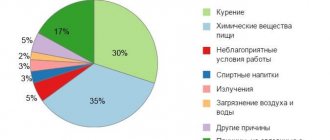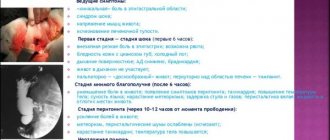Gastric obstruction is a pathological condition characterized by a disruption (partial or complete) of the movement of food along the digestive tract. Having lost the opportunity to leave the stomach, digested food stagnates in it, causing stretching of the gastric wall, which can impair blood flow and oxygen supply.
Thanks to the current situation, a favorable environment arises in the stomach for the rapid development of pathogenic microflora. This rare pathology can occur in both a teenage child and an adult patient.
Reasons for development
Most often, gastric obstruction occurs due to:
- Inflammatory or infectious processes occurring in this organ or in the intestinal structures.
- Large neoplasms developing as a result of oncological lesions of the gastrointestinal tract. Obstruction, as a rule, occurs in patients with advanced stages of cancer, in which a malignant tumor that has invaded all layers of the gastric wall significantly deforms it.
- An intestinal ulcer localized in the area of the pylorus of the stomach and causing a significant narrowing of this organ.
- Tuberculosis of the gastrointestinal tract.
- Intestinal atresia (a pathological condition characterized by the congenital absence or overgrowth of natural openings and canals in the patient’s body).
- Clogging of the stomach with inedible, rather large and hard objects consumed as food, which the human body simply cannot digest and assimilate.
- Esophageal diverticulum.
- Coprostasis (fecal impaction) is a pathological condition in which the lumen of a strangulated intestinal loop is blocked by feces, causing intestinal obstruction.
- The occurrence of adhesions.
- Formation of gastric fistulas. An example is a fistula that forms between the gallbladder and the stomach.
- Foreign bodies (bezoars) formed in the stomach as a result of matting of hair, pet hair or plant fibers. The medical literature describes a case where gastric obstruction was caused by a large amount of cotton wool eaten by a patient suffering from mental illness.
- Disturbances of normal blood circulation in the human body, caused by infringement of internal organs when hernias occur.
- Intussusception is an intestinal obstruction that develops as a result of the penetration of one part of the intestine into the lumen of another.
- Gallbladder stone blocking the pyloric canal of the stomach.
Causes
What causes intestinal obstruction? There are many reasons for this disease. To find out what led to the retention of food and water, a number of diagnostic examinations are carried out.
The data obtained helps the doctor determine that the violation occurred as a result:
- reflex spasm in the intestinal area, which developed due to recent surgery, trauma to the abdomen or spine, passage of a stone through the ureter, etc.;
- paresis or paralysis of a section or the entire intestine resulting from another disease: peritonitis, diabetes, poisoning, thrombosis of small vessels, etc.;
- blocking the intestinal lumen from the inside with a mechanical obstacle: a tumor, scars, gallstones, worms, a lump of food with undigested fibers, a foreign body;
- blocking the intestinal lumen from the outside by squeezing the area with a hernia, adhesions as a result of intestinal volvulus, malformations of the organ, or the cause was intussusception.
The causes of intestinal obstruction determine treatment tactics. Therefore, their establishment is an important stage of medical care. Read more about the causes of intestinal obstruction in children→
Symptoms of gastric obstruction in adults and newborns
Symptoms of gastric obstruction, characterized by a wide variety of clinical manifestations, may depend on:
- etiology of the disease;
- degree of infectious damage to the body;
- the presence of malignant neoplasms;
- localization of the organ affected by the infection;
- individual characteristics of the patient's body.
Most often, gastric obstruction manifests itself:
- The occurrence of nausea and vomiting. Partially digested food masses, unable to enter the intestines, are eliminated from the body through vomit, which has a rotten taste and smell. In patients suffering from cancer, in the vomit consisting of semi-digested food eaten the day before, a significant amount of blood clots and mucus, as well as particles of intragastric tissue, colored greenish, are found.
- The presence of belching with an extremely unpleasant odor.
- Feeling of constant heaviness in the upper abdomen.
- A feeling of oversaturation that persists for several hours after the next meal and disappears only after vomiting.
- Discomfort and pain that occurs in the intestinal area.
- A sharp decrease in weight due to the fact that food that does not reach the intestines is not absorbed by the patient’s body.
- The presence of intense spasmodic pain in the abdomen.
- Asymmetrical bloating.
- Retention of stool and difficult passage of gases.
- The presence of bloody discharge in the stool.
- Relaxation of the anal sphincter.
- Intoxication of the body.
- Sharp uncontrollable tension in the anterior abdominal wall.
- Accumulation of gases in the large intestine.
- A splashing noise that occurs above the intestines and is clearly audible upon auscultation.
When gastric obstruction is just forming, the appearance of alarming symptoms is noted only at the moment of eating either solid food or too much of it. As the pathology progresses, problems arise with eating foods that have a semi-liquid or liquid consistency.
In newborn infants, the symptoms of gastric obstruction may be closely related to congenital intestinal obstruction caused by malformations of the gastrointestinal tract:
- One of the variants of this congenital pathology is pyloric stenosis - narrowing of the pylorus of the stomach. Significantly complicating the penetration of partially digested milk into the intestines, pyloric stenosis manifests itself with the occurrence of profuse - fountain - vomiting already in the first days of a child’s life.
- Intestinal obstruction can also be caused by its atypical location or torsion of intestinal loops.
- In 15% of infants suffering from cystic fibrosis, meconium ileus is observed - congenital obstruction of the small intestine, in which its lumen is blocked by meconium - original feces with increased viscosity.
- The cause of coprostasis in infants (and older) children can be a congenital defect consisting of elongation of the sigmoid colon. Fecal blockage, as a rule, blocks the lumen of the end section of the small or large intestine.
Very rare pathologies include congenital atresia of the stomach, which manifests itself either in the fusion of its internal structures, or in the filling of holes and canals, as a result of which neither the free movement of the food coma through the digestive tract nor the digestion of food becomes impossible.
Gastric atresia in newborns is most often prepyloric. A characteristic feature of this pathology is the appearance of a flexible membrane at the junction of the stomach and duodenum. It is distinguished from stenosis by the complete absence of any holes in the blocked lumen.
A separate discussion requires obstruction of the pyloric part of the stomach, called pyloric stenosis, which occurs as a complication of peptic ulcer disease.
After scarring of an ulcer located near the pyloric sphincter, deformation of the stomach occurs, manifested by a narrowing of its outlet, the lumen of which is covered with a thin membrane that has a heterogeneous thickness, structure and many small holes of different sizes, the total area of which is more than 50% of the area of the membrane itself.
Located in the pyloric canal of the stomach and initially of insignificant thickness, the membrane has a mucous membrane, a submucosal layer and rare inclusions of muscle structures. If adequate therapy is absent, the size of the membrane and the thickness of its walls increase. Over time, the tissues of the thickened membrane acquire a structure whose structure is no different from the structure of the gastric walls.
Early symptoms of pyloric stenosis resemble the clinical picture of peptic ulcer disease. The general condition of the patient remains close to normal. He complains of a feeling of heaviness in the stomach and relatively infrequent vomiting, which brings relief. Vomit, which has a pronounced acidic taste, consists of gastric contents.
Probing, systematic gastric lavage, and pumping out oxidized contents improve the patient’s well-being by normalizing patency.
However, the stenosis does not go away and continues to gradually progress, manifesting itself:
- hypertrophy of the gastric walls;
- decreased muscle tone of internal organs;
- increased frequency of vomiting and increased volume of vomit;
- rapid loss of body weight;
- development of atony;
- overdistension of the stomach, leading to an increase in its size;
- weakening and dehydration of the body;
- metabolic disorders;
- increased constipation.
Symptoms in the presence of cancer in the stomach
In the presence of gastric obstruction, the symptoms directly depend on the exact stage of the disease. The most common sign that something is wrong is excessive vomiting. Due to the fact that products cannot enter the intestines, they are thrown out. Against this background, the released masses have an unpleasant and putrid odor. Often, as mentioned earlier, the cause of such obstruction can be large malignant gastric neoplasms (tumors), which over time atrophy the organ.
View gallery
With gastric obstruction due to cancer, the patient will constantly feel a feeling of nausea, and in addition, he will also be accompanied by heaviness after eating along with profuse vomiting. Against this background, the vomit may contain undigested food debris with mucus with a green tint and blood clots.
Classification
Depending on the nature of development, gastric obstruction, occurring in acute or chronic form, can be:
- Mechanicalcaused by the presence of any mechanical obstacle (foreign body, cyst, tumor) in the organ cavity. In addition, the cause of the development of mechanical obstruction, which prevents the normal movement of the food coma from the stomach into the intestines, can be:
- Gastric volvulus is a rare pathology consisting of a rotation of this organ around its transverse or longitudinal axis by 180-360 degrees;
- strangulation of the stomach in the esophageal opening of the diaphragm;
- helminthic infestation;
- presence of fistulas or gallstones;
- coprostasis (stool stagnation).
- Dynamic , caused by a violation of the motor function of internal organs and in no way related to mechanical stress. The cause of this pathology can be either a decrease or an increase in the tone of the muscle structures of the intestines and stomach.
- Mixed , accompanied by the occurrence of intussusception and the formation of adhesions.
Intestinal obstruction - causes, symptoms and treatment
The causes of intestinal obstruction predetermine its division into mechanical, which is caused by an obstruction in the intestine, the wall, or completely outside the intestine. The causes of obstruction (mechanical) can also be the rotation of the digestive tube around its axis or narrowing of the lumen.
Dysfunction of the nerves supplying the intestinal wall is caused by functional (neurogenic) obstruction. In this case, the wall is either overly irritated (spasmodic ileus) or paralyzed (paralytic ileus). Vascular diseases of the abdominal wall are the cause of vascular obstruction in the intestine.
Not many people know that even stress can lead to ileus. Therefore, people who are sensitive to stressful situations must learn to cope with them, since the root cause of the problem must be treated first.
Diagnostics
The primary stage of diagnosis is a physical examination of the patient, which involves the mandatory use of palpation and percussion.
Auscultation (listening to sounds made by functioning internal organs) reveals stenotic-type peristalsis, characteristic of impaired pyloric function.
The presence of high-pitched whistling noises is explained by the pushing of gastric contents through the stenotic area. The complete absence of peristalsis, called “dead silence,” indicates that mechanical obstruction of the stomach has become paralytic.
Instrumental diagnosis of gastric obstruction consists of:
- Fibrogastroscopy with the introduction of a contrast agent, which helps to detect an obstacle that prevents the free passage of a food coma, as well as visually examine and describe in detail the nature of this obstacle and the condition of the walls of the stomach. Microscopic analysis of samples taken during a biopsy can detect the presence of malignant neoplasms.
- X-rays with contrast. Thanks to the contrast agent, the doctor conducting the examination can easily find an object that impairs the patency of the organ and retains food in the stomach. In addition, he gets the opportunity to assess the degree of narrowing of the gastric outlet.
Uniform filling of the stomach with a radiopaque substance, combined with blocking and deformation of the outlet, as well as the presence of stretches on the walls of the organ (just above the area of stenosis) indicate obstruction of the pyloric part of the stomach caused by an ulcer.
A narrowing localized both in one and in all parts of the stomach, provoking uneven deformation of the affected organ, which has uneven, “eaten away” contours, indicates the presence of an oncological lesion.
Some types of malignant neoplasms provoke severe contraction of the gastric walls, leading to significant deformation of the lumen, as a result of which the affected organ takes the shape of a pistol holster.
- An overview image of the abdominal cavity (during the procedure, the patient can stand or lie on his left side). The distribution of gas and liquid levels is used to judge the localization of the pathological process. The common bile duct (choledochus), filled with air, indicates gastric obstruction, the culprit of which is a gall bladder stone. To contrast the large intestine, gastrografin (an aqueous solution of iodine) is used, the passage of which helps to establish the localization of intestinal obstruction.
- Ultrasound examination of the abdominal cavity.
First aid
Since clinical manifestations of gastric obstruction in the early stages of the disease are practically absent, there is no need to provide any pre-medical care.
Sanitary care for the patient may be required only in case of vomiting: it must be provided with a special container for vomit and napkins intended for wiping hands and face.
After stopping vomiting and performing sanitary and hygienic procedures, the patient must be admitted to a medical hospital, where he can receive qualified treatment.
Classification of the disease
The causes of CI and the variety of its forms create some difficulties in diagnosing the surgical disease.
Based on the clinical manifestations of the disease, in medicine there are two types of its course - acute obstruction, which is the most common form, and a chronic form, which is quite rare.
The mechanism of development of the disease determines all its varieties.
Dynamic intestinal obstruction often occurs in elderly people, patients with acute myocardial infarction, acute pancreatitis, and after abdominal surgery.
Dynamic disease comes in spastic and paralytic forms.
CN is divided into obstructive, when the passage to the intestine is blocked by feces, gallstones or a foreign body, and strangulation, which occurs due to strangulation, volvulus, nodes and compressive vessels of the mesentery.
- Complete CI – expressed by the completeness of symptoms;
- Partial - with less pronounced symptoms, since the organ is not completely blocked and continues to function.
- Non-reflexive stage. It lasts from 6 to 12 hours. Manifested by cramping pain, rumbling, increased peristalsis, vomiting, stool retention;
- Intoxication stage. The form is characterized by a change in symptoms - a decrease in pain, but its nature becomes constant, increased vomiting, tachycardia, decreased blood pressure;
- Stage of peritonitis. It occurs within 24 hours and manifests itself as severe intoxication. The patient begins to vomit, the masses of which have the smell of feces, there is a painful swollen abdomen, an increased reduction in heart rate, and a worsening of facial features.
In the dynamics of the development of the disease, three stages are distinguished, in the event that help is not possible in the first or second stages.
The main symptoms of hormonal imbalance in women are the necessary treatment when identifying and preventing this disease.
Have you heard about such a disease in women as ureaplasmosis? Read about the signs of the disease and how ureaplasma is treated here.
Chronic cystitis - women at risk! Comprehensive treatment of cystitis in women, relief of acute pain - you will find out in the review.
Treatment
Treatment of gastric obstruction is carried out in a surgical hospital.
After a thorough medical examination and an accurate diagnosis are made, treatment tactics are considered and a decision is made on the advisability of surgical intervention.
If it was not possible to immediately diagnose the pathology or there are doubts about the correctness of the diagnosis, they resort to drug (conservative) treatment and a number of additional diagnostic procedures.
Conservative treatment includes:
- Probing of the affected stomach and duodenum.
- Infusion (intravenous infusion) of fluid and electrolytes into the patient’s dehydrated body, carried out using droppers.
- Setting up siphon enemas.
- Bladder catheterization (placement of a catheter allows you to control the volume of fluid entering and exiting the body).
- Taking medications prescribed by your doctor.
Patients suffering from gastric obstruction should remain in bed and lead a quiet lifestyle, excluding heavy physical activity.
Of great importance is strict adherence to a special diet, which includes:
- Consumption of mechanically and chemically gentle dishes that have undergone minimal heat treatment and are served to the patient pureed and warm.
- Five to six meals per day. The intervals between them should not exceed three hours.
- Mandatory inclusion in the daily diet of protein-enriched puree soups, pureed viscous porridges and jelly.
- Exclusion from the diet of hot seasonings, marinades, pickles, smoked foods, fatty and carbohydrate-rich foods.
- Use of dietary supplements and vitamins.
Surgical treatment is resorted to only in cases where conservative therapy has not led to the expected result. The exception is cases of thrombosis of the mesenteric vessels of the intestine, which pose a threat to the lives of patients. In these cases, surgery is performed immediately.
Surgeries aimed at eliminating gastric obstruction have many options. During their implementation, the surgeon can:
- carry out decompression (consisting of removing foreign bodies or cutting adhesions);
- start restoring the passage;
- resort to resection (removal) of necrotic areas;
- perform an end-to-end anastomosis.
Eliminating the obstruction caused by the gallstone, the surgeon removes it using enterotomy, after which he resorts to suctioning the gastric contents. To eliminate ulcerative obstruction, a drainage operation is performed aimed at releasing the outlet of the stomach.
What to do: first aid, which doctor to go to
If you suspect this dangerous condition, you should urgently call an ambulance. The disease develops quite quickly , and the timing of the patient’s admission to a medical facility determines the outcome of the disease.
Treatment tactics for NK depend on the causes of the condition. Most cases do not survive without urgent abdominal intervention.
But with the dynamic development of the disease, conservative treatment methods are used.
In any case, if symptoms are severe, you should consult a doctor who will prescribe adequate therapy.
Complications
Gastric obstruction can:
- cause a state of shock;
- provoke the occurrence of severe pain;
- become paralytic (if it lasts for a long time);
- significantly worsen the condition of the body;
- provoke the occurrence of concomitant infectious and oncological diseases;
- significantly limit the patient’s mobility;
- destroy the internal microflora of this organ, which will certainly lead to a weakening of the body’s defenses;
- lead to death.
General signs of intestinal obstruction
Increased peristalsis over the barrier causes colic and pain in the abdomen, which subsides with a decrease in peristalsis. Irritation of the nerve endings can lead to persistent abdominal pain.
Vomiting is a constant sign of acute intestinal obstruction.
Other symptoms of intestinal obstruction include the following:
- Vomiting, which may occur if the barrier is located near the stomach or further from the accumulation of intestinal contents. The closer to the rectum the barrier is located, the later vomiting occurs. Flatulence and stool retention occur when the barrier is low.
- With intestinal obstruction, signs of dehydration may appear, caused by vomiting and leakage of fluid into the abdominal cavity, and accumulation of blood in the intestinal venous system. Dehydration syndrome is manifested by thirst, dry mouth, decreased skin elasticity, a feeling of weakness, and sometimes fever.
Prevention
To prevent gastric obstruction, every person should:
- Treat gastrointestinal pathologies in a timely manner.
- Lead a fairly active lifestyle, including regular sports (especially swimming and physical therapy) and regular walks in the fresh air.
- Regularly undergo scheduled medical examinations.
- Pay great attention to your diet, avoiding fatty and high-carbohydrate foods and including plenty of fresh herbs, fruits and vegetables.
- Prevent helminthic infestations on a quarterly basis.
- Regularly take tests for tumor markers, which allow you to diagnose cancer at the earliest stages.
- If necessary, take medications prescribed by your doctor.
- Never self-medicate.
Treatment of intestinal obstruction
Features of treatment depend on the form of intestinal obstruction, its neglect and medical prognosis in each specific case. If the patient seeks help in the early stages of CI, then there is a possibility that conservative therapy will be carried out:
- cleansing the upper gastrointestinal tract through a special probe;
- administration of drugs that stimulate motor skills;
- administration of drugs that relieve spasms from the gastrointestinal tract.
If after conservative treatment there is no improvement in the patient’s condition within 12 hours, surgical intervention is used. During the operation, surgeons make an incision in the abdominal cavity, determine the cause of the problem and eliminate it depending on the form of the disease, for example:
- remove part of the intestine if it is necrosis;
- remove adhesions and tumors;
- correct volvulus and intestinal knots;
- in case of peritonitis, sanitation and drainage of the abdominal cavity are performed.










